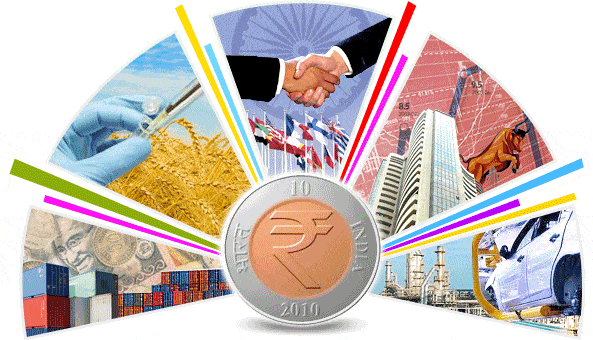Sectors of the Indian Economy
- Economic activities can be divided into three main sectors
- Primary sector
- Secondary Sector
- Tertiary Sector
- Primary Sector– producing a good by exploiting natural resources. Primary because it forms the base for all other products that we subsequently make. It is also called agriculture and related sector.
- Secondary Sector – natural products are changed into other forms through ways of manufacturing associated with industrial activity. It is the next step after primary activity. It is also called as industrial sector.
- Tertiary Sector – activities that help in the development of primary and secondary sectors. These activities generate services like transportation, communication etc. and not goods. It is also called as the service sector.
- All the three sectors of economy are highly interdependent.
Gross Domestic Product (GDP):
It is the value of all final goods & services produced within a country during a particular year. It shows how big the economy is.
Contents
- The general pattern observed in developed countries is a shift from the primary sector to the secondary sector and then eventually to the tertiary sector over a period of time. But in case of India, the share in GDP of the service sector has increased manifold and that of primary sector has reduced drastically.
- But a similar shift has not taken place in employment. The primary sector continues to be the largest employer even now.
- Reason: Not enough jobs were created in the secondary and tertiary sectors.
- This means that there are more people in agriculture than required. Production will not be affected even if a few of them are removed. They are under employed.
- This kind on underemployment is hidden in contrast to someone who does not have a job & is clearly visible as unemployed. Also called disguised unemployment.
- What is unemployment? When an individual has the ability and willingness to work but still he has no job.
-
Types of unemployment:
- Disguised, Seasonal, Cyclic, Visible and Technological
- Seasonal unemployment: For example, in the agricultural sector, farmers remain unemployed between the sowing and harvesting period. The government has tried to tackle the problem by generating employment through long-term infrastructure development projects.
- Cyclic unemployment: It depends upon the fluctuation of demand and supply in the market. The demand for umbrellas increases during the rainy season while falls during the other seasons. Hence, the umbrella makers remain cyclically unemployed.
- Visible unemployment: seen in both urban and rural sectors. An individual has the ability and willingness but the country fails to provide job opportunities.
- Technological unemployment: displacement of laborers by innovative technologies.
How to create employment opportunities?
- In rural areas: undertaking long term infrastructure development projects, providing easy credit to farmers, providing incentives to the farmers like crop subsidies and irrigation facilities.
- In urban areas: Skill development, entrepreneurial development, emphasizing vocationalism in education
- The central government made a law called the National Rural Employment Guarantee Act, 2005 (NREGA); implementing the Right to Work enshrined in the constitution as one of the Directive Principles of State Policy (Article 41).
- Under NREGA, all those who are able to and are in need of work are guaranteed 100 days of employment in a year by the government. If the government fails in its duty to provide employment, it will give unemployment allowances to the people.
Division of sectors as organised and unorganized:
- Organised: covers those enterprises or place of work where the terms of employment are regular & people have assured work. They are registered by the government. They abide by laws of the government. For ex factories act, minimum wages act.
- Unorganized: They are small and scattered units & are outside the control of government. They do not follow rules & regulations. Jobs are low paid and irregular. Employment is not secure with no benefits. These workers also face social discrimination.
Protection and support to the unorganized sector workers is necessary for both economic and social development.
Also Read:Class X- Chapter-2 Sectors of the Indian Economy
Sectors in terms of ownership:
- Public sector: the government owns most of the assets and provides all the services. For eg; Railways. Their motive is public and social welfare.
- Private sector: ownership of assets and delivery of services is in the hands of private individuals and companies. For eg; TISCO. Their motive is to earn profits.
Various infrastructure development projects require huge investments and the return is also very less. So the private sector is less inclined to invest in them.











